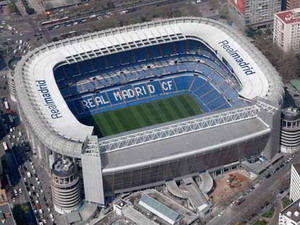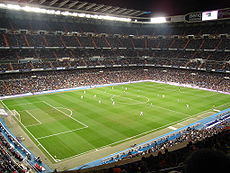 

Royal Palace (Palacio Real
de Madrid):
| The Royal Palace of Madrid
(Spanish: Palacio Real de Madrid) is the official residence of the King
of Spain, located in Madrid. King Juan Carlos and the royal family do not
reside in this palace, instead choosing the smaller Palacio de la Zarzuela,
on the outskirts of Madrid. The palace is owned by the Spanish state and
administered by the Patrimonio Nacional agency. However, the Palacio Real
de Madrid is still used for state occasions.
The palace is located on
Bailén street, in the western part of downtown Madrid, east of the
Manzanares River, and is accessible from the Ópera metro station.
The palace is partially open to public, except when in official use.
The palace also has the distinction
of being the largest royal palace in Western Europe in size, with over
a combined area of over 135,000m² and more than 2,800 rooms. |

Plaza
De Oriente and Palacio Real, Madrid, Spain
Buy
at AllPosters.com
|
History
The site of the palace dates
from a 10th-century fortress, called mayrit, constructed as an outpost
by Mohammed I, Emir of Córdoba and inherited after 1036 by the independent
Moorish Kingdom of Toledo. After Madrid fell to Alfonso VI of Castile in
1085, the edifice was only rarely used by the kings of Castile. In 1329,
King Alfonso XI of Castile convoked the cortes of Madrid for the first
time. Philip II moved his court to Madrid in 1561.
The Antiguo Alcázar
("Old Castle") was built on the location in the 16th century. It burned
on December 24, 1734; King Philip V ordered a new palace built on the same
location. Construction spanned the years 1738 to 1755 and followed a Berniniesque
design by Filippo Juvarra and Giovanni Battista Tiepolo in cooperation
with Ventura Rodríguez, Francesco Sabatini, and Scirmento. The new
palace, directly facing the cathedral across the Plaza de Armas, was occupied
by Carlos III in 1764.
Today
The vast palace is richly
decorated by artists such as Velázquez, Tiepolo, Mengs, Gasparini,
Juan de Flandes, Caravaggio, and Goya. Several royal collections of great
historical importance are kept at the palace, including the Royal Armoury
and weapons dating back to the 13th century, and the world's only complete
Stradivarius string quintet, as well as collections of tapestry, porcelain,
furniture, and other objects of great historical importance.
Below the palace, to the
west, are the gardens of the Campo del Moro that were given this name due
to the fact that here in the year 1109, Muslim leader Ali Ben Yusuf, encamped
with his men in the attempt to recapture Madrid and its Alcázar
(fortress) from the Christians. The east façade of the palace gives
onto the Plaza de Oriente and the Teatro Real opera house. To the south
is a vast square, the Plaza de la Armas, surrounded by narrow wings of
the palace, and to the south of that is located the Catedral de la Almudena.
To the north are the Jardines de Sabatini (Sabatini Gardens), named after
one of the architects of the palace.
The wedding banquet of Prince
Felipe and Letizia Ortiz took place on 22 May 2004 at the central courtyard
of the Palace.
The palace is open to the
public and it is closed when used by the king for state functions like
state banquets for visiting heads of state, official government receptions
and the presentation of new ambassadors to the king.

|
Top
|
Estadio
Santiago Bernabéu - Santiago Bernabéu Stadium
Estadio Santiago Bernabéu
is a football stadium in Madrid, Spain. It is the home of Real Madrid.
Work on the grounds started on October 27 1944. Originally called Estadio
Chamartín after Madrid's previous stadium, it was inaugurated in
December 1947. Real Madrid officially adopted the present name, Estadio
Santiago Bernabéu, on January 4, 1955 in honour of the club president
Santiago Bernabéu. The stadium has been officially sanctioned by
UEFA as Elite or 5 Star on its 60th year of its existence.
 The
capacity has changed frequently, peaking at 120,000 after a 1953 expansion.
Since then there have been a number of reductions due to modernisations
(the last standing places went away in 1998/99 in response to UEFA regulations
which forbid standing at matches in the UEFA competition), countered to
some extent by expansions. The last change was an increase of about five
thousand to a capacity of 79,400, effected in 2003. A plan to add a retractable
roof has been announced. The
capacity has changed frequently, peaking at 120,000 after a 1953 expansion.
Since then there have been a number of reductions due to modernisations
(the last standing places went away in 1998/99 in response to UEFA regulations
which forbid standing at matches in the UEFA competition), countered to
some extent by expansions. The last change was an increase of about five
thousand to a capacity of 79,400, effected in 2003. A plan to add a retractable
roof has been announced.
The Bernabéu is one
of the world's most famous and prestigious venues. It has hosted the European
Cup final on three separate occasions (in 1957, 1969 and 1980), and is
scheduled to host the 2010 final. The finals for the 1964 European Nations'
Cup and the 1982 World Cup have also been held at the Bernabéu.
The stadium has its own Madrid
Metro station along the 10 line called Santiago Bernabéu. Its location,
in the heart of Madrid's business district, is quite unusual for a football
stadium.
After its foundation in 1902
the club moved in their first years between some minor grounds before moving
to the 'Campo de O'Donnell' in 1912.
This ground remained their
home ground for eleven years. After these years the club made a move again,
this time to the 'Campo de Ciudad Lineal', a small ground with a capacity
of 8,000 spectators. This time, it would only be a short stay, because
after only twelve months the club moved again. This new ground would make
a longer appearance. The 'Estadio Chamartín' was inaugurated on
the 17th of May 1923 with a match of Real Madrid against Newcastle United.
In this stadium, which hosted 22,500 spectators, Real Madrid celebrated
their first Spanish league titles.
 After
those successes, in 1943 elected president Don Santiago de Bernabeu decided
that the Estadio de Chamartin wasn't big enough for the ambitions of the
club. A new stadium had to be built, which was inaugurated on the 14th
of December 1947. This was the 'Estadio Santiago Bernabeu' as we know it
today, although it didn't acquire this name until 1955. The first match
to be played in the new stadium was between Real Madrid and Portuguese
side Belenenses from Lisbon (3-1). Sabino Barinaga scored the first goal
in the new stadium. The initial capacity was 75,300. After
those successes, in 1943 elected president Don Santiago de Bernabeu decided
that the Estadio de Chamartin wasn't big enough for the ambitions of the
club. A new stadium had to be built, which was inaugurated on the 14th
of December 1947. This was the 'Estadio Santiago Bernabeu' as we know it
today, although it didn't acquire this name until 1955. The first match
to be played in the new stadium was between Real Madrid and Portuguese
side Belenenses from Lisbon (3-1). Sabino Barinaga scored the first goal
in the new stadium. The initial capacity was 75,300.
In 1953, a first extension
to the stadium was realized with the addition of a third tier. This increased
the capacity to an overwhelming 120,000.
At the same time a great
team was formed in Madrid that would win many trophies in the next years.
One of these trophies was won in their own Santiago Bernabeu; their second
European Cup against Fiorentina (2-0). In the next years more European
Cup finals would be played in the stadium (1969: AC Milan-Ajax & 1980:
Nottingham Forest-HSV). The first official match of the Spanish national
team in the Santiago Bernabeu was played in the year 1964 (Franco-Stalin).
Due to the upcoming World
Cup championships in 1982 the stadium had to be renovated again. This decreased
the capacity to a mere 90,000.
The matches in pool B (Germany,
Spain & England) and the final between Italy and Germany (3-1) were
played in the Bernabeu stadium.
In 1992 the stadium was extended
again to a capacity over 100,000 (106,500). At the same the exterior of
the stadium was renovated, which resulted in the exterior as we know it
today, including the remarkable entrance towers at the corners.
This new increase in capacity
led to a harsh competition with rival FC Barcelona about which stadium
could host the most spectators. This battle was ultimately lost by Real
Madrid in the season 1998/1999 when all standing places had to be converted
into seats according to UEFA rules. This led to a capacity decrease to
74,300.
A new renovation has been
completed. This renovation of the east stand has increased the capacity
to 80,000 and has made the stadium totally covered.
The ex-president of Real
Madrid, Florentino Perez, announced in 2005, before quitting the club,
a proposal to construct a retractable roof on the stadium. The construction
has not yet started.
Top
|

|

